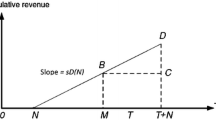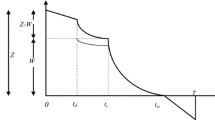Abstract
In a supplier-retailer-customer supply chain, a credit-worthy retailer frequently receives a permissible delay on the entire purchase amount without collateral deposits from his/her supplier (i.e., an up-stream full trade credit). By contrast, a retailer usually requests his/her credit-risk customers to pay a fraction of the purchase amount at the time of placing an order, and then grants a permissible delay on the remaining balance (i.e., a down-stream partial trade credit). Also, in selecting an item for use, the selling price of that item is one of the decisive factors to the customers. It is well known that the higher selling price of item decreases the demand rate of that item where the lesser price has the reverse effect. Hence, the demand rate of an item is dependent on the selling price of that item. In addition, many products such as fruits, vegetables, high-tech products, pharmaceuticals, and volatile liquids not only deteriorate continuously due to evaporation, obsolescence and spoilage but also have their expiration dates. However, only a few researchers take the expiration date of a deteriorating item into consideration. This paper proposes an economic order quantity model to allow for: (a) the strategy that supplier offers retailer a full trade credit policy whereas the retailer offers their customers a partial trade credit policy, (b) selling price dependent demand rate, (c) a profit maximization objective and (d) deteriorating items not only deteriorate continuously but also have their expiration dates. For the objective function sufficient conditions for the existence and uniqueness of the optimal solution are provided. An efficient algorithm is designed to determine the optimal pricing and inventory policies for the retailer. Finally, numerical examples are presented to illustrate the proposed model and the effect of key parameters on optimal solution is examined.
Similar content being viewed by others
References
Aggarwal, S.P., Jaggi, C.K.: Ordering policies of deteriorating items under permissible delay in payments. J. Oper. Res. Soc. 46, 658–662 (1995)
Bakker, M., Riezebos, J., Teunter, R.H.: Review of inventory systems with deterioration since 2001. Eur. J. Oper. Res. 221(2), 275–284 (2012)
Balkhi, Z.T.: Optimal economic ordering policy with deteriorating items under different supplier trade credits for finite horizon case. Int. J. Prod. Econ. 133, 216–223 (2011)
Biskup, D., Simon, D., Jahnke, H.: The effect of capital lockup and customer trade credits on the optimal lot size A confirmation of the EPQ. Comput. Oper. Res. 30, 1509–1524 (2003)
Bhigham, E.F.: Fundamentals of financial management. The Dyden pren Florida (1995)
Chang, C.T., Ouyang, L.Y., Teng, J.T., Cheng, M.C.: Optimal ordering policies for deteriorating items using a discounted cash-flow analysis when a trade credit is linked to order quantity. Comput. Ind. Eng. 59, 770–777 (2010)
Chang, C.T., Teng, J.T., Chern, M.S.: Optimal manufacturers replenishment policies for deteriorating items in a supply chain with up-stream and downstream trade credits. Int. J. Prod. Econ. 127, 197–202 (2010)
Chen, S.C., Teng, J.T.: Retailer’s optimal ordering policy for deteriorating items with maximum lifetime under supplier’s trade credit financing. Appl. Math. Model. 38, 4049–4061 (2014)
Chen, S.C., Teng, J.T., Skouri, K: Economic production quantity models for deteriorating items with up-stream full trade credit and down-stream partial trade credit. Int. J. Prod. Econ. 155, 302–309 (2014)
Chern, M.S., Pan, Q., Teng, J.T., Chan, Y.L., Chen, S.C.: Stackelberg solution in a vendor-buyer supply chain model with permissible delay in payments. Int. J. Prod. Econ. 144(1), 397–404 (2013)
Chung, K.J., Huang, T.S.: The optimal retailer’s ordering policies for deteriorating items with limited storage capacity under trade credit financing. Int. J. Prod. Econ. 106, 127–145 (2007)
Chung, K.J., Huang, Y.F.: The optimal cycle time for EPQ inventory model under permissible delay in payments. Int. J. Prod. Econ. 84, 307–318 (2003)
Chung, K.J.: The EPQ model under conditions of two levels of trade credit and limited storage capacity in supply chain management. Int. J. Syst. Sci. 44, 1675–1691 (2013)
Dye, C.Y., Ouyang, L.Y.: A particle swarm optimization for solving joint pricing and lot-sizing problem with fluctuating demand and trade credit financing. Comput. Ind. Eng. 60, 127–137 (2011)
Feng, H., Li, J., Zhao, D.: Retailers optimal replenishment and payment policies in the EPQ model under cash discount and two-level trade credit policy. Appl. Math. Model. 37, 3322–3339 (2013)
Goyal, S.K.: Economic order quantity under conditions of permissible delay in payments. J. Oper. Res. Soc. 36, 335–338 (1985)
Ho, C.H.: The optimal integrated inventory policy with price-and-creditlinked demand under two-level trade credit. Comput. Ind. Eng. 60, 117–126 (2011)
Huang, Y.F.: Optimal retailer’s ordering policies in the EOQ model under trade credit financing. J. Oper. Res. Soc. 54, 1011–1015 (2003)
Huang, Y.F.: An inventory model under two-levels of trade credit and limited storage space derived with out derivatives. Appl. Math. Model. 30, 418–436 (2006)
Huang, Y.F.: Economic order quantity under conditionally permissible delay in payments. Eur. J. Oper. Res. 176, 911–924 (2007)
Huang, Y.F.: Optimal retailer’s replenishment decisions in the EPQ model under two levels of trade credit policy. Eur. J. Oper. Res. 176, 1577–1591 (2007)
Huang, Y.F., Hsu, K.H.: An EOQ model under retailer partial trade credit policy in supply chain. Int. J. Prod. Econ. 112, 655–664 (2008)
Jaber, M.Y.: Lot sizing with permissible delay in payments and entropy cost. Comput. Ind. Eng. 52, 78–88 (2007)
Jaggi, C.K., Goyal, S.K., Goel, S.K.: Retailer’s optimal replenishment decisions with credit-linked demand under permissible delay in payments. Eur. J. Oper. Res. 190, 130–135 (2008)
Jaggi, C.K., Verma, M.: Ordering policies under supplierretailer partial trade credit financing. Opsearch 47, 293–310 (2010)
Kreng, V.B., Tan, S.J.: The optimal replenishment decisions under two levels of trade credit policy depending on the order quantity. Expert Syst. Appl. 37, 5514–5522 (2010)
Kreng, V.B., Tan, S.J.: Optimal replenishment decision in an EPQ model with defective items under supply chain trade credit policy. Expert Syst. Appl. 38, 9888–9899 (2011)
Liao, H.C., Tsai, C.H., Su, C.T.: An inventory model with deteriorating items under inflation when a delay in payment is permissible. Int. J. Prod. Econ. 63, 207–214 (2000)
Mahata, G.C., Goswami, A.: Production lot-size model with fuzzy production rate and fuzzy demand rate for deteriorating item under permissible delay in payments. Opsearch 43(4), 358–375 (2006)
Mahata, G.C., Goswami, A.: An EOQ model for deteriorating items under trade credit financing in the fuzzy sense. Prod. Plan. Control 18(8), 681–692 (2007)
Mahata, G.C., Mahata, P.: Analysis of a fuzzy economic order quantity model for deteriorating items under retailer partial trade credit financing in a supply chain. Math. Comput. Model. 53, 1621–1636 (2011)
Mahata, G.C.: An EPQ-based inventory model for exponentially deteriorating items under retailer partial trade credit policy in supply chain. Expert Syst. Appl. 39, 3537–3550 (2012)
Min, J., Zhou, Y.W., Zhao, J.: An inventory model for deteriorating items under stock-dependent demand and two-level trade credit. Appl. Math. Model. 34, 3273–3285 (2010)
Min, J., Zhou, Y.W., Liu, G.Q., Wang, S.D.: An EPQ model for deteriorating items with inventory-level-dependent demand and permissible delay in payments. Int. J. Syst. Sci. 43, 1039–1053 (2012)
Ouyang, L.Y., Chang, C.T., Teng, J.T.: An EOQ model for deteriorating items under trade credits. J. Oper. Res. Soc. 56, 719–726 (2005)
Sana, S.S., Chaudhuri, K.: A deterministic EOQ model with delays in payments and price-discount offers. Eur. J. Oper. Res. 184, 509–533 (2008)
Seifert, D., Seifert, R.W., Protopappa-Sieke, M.: A review of trade credit literature: opportunity for research in operations. Eur. J. Oper. Res. 231(2), 245–256 (2013)
Shinn, S.W.: Determining optimal retail price and lot size under day-terms supplier credit. Comput. Ind. Eng. 52, 717–720 (1997)
Soni, H.N.: Optimal replenishment policies for deteriorating items with stock sensitive demand under two-level trade credit and limited capacity. Appl. Math. Model. 37, 5887–5895 (2013)
Soni, H.N., Patel, K.A.: Optimal strategy for an integrated inventory system involving variable production and defective items under retailer partial trade credit policy. Decis. Support Syst. 54, 235–247 (2012)
Taleizadeh, A.A.: An EOQ model with partial backordering and advance payments for an evaporating item. Int. J. Prod. Econ. (2014). doi:10.1016/j.ijpe.2014.01.023 , in press
Teng, J.T.: On the economic order quantity under conditions of permissible delay in payments. J. Oper. Res. Soc. 53, 915–918 (2002)
Teng, J.T.: Optimal ordering policies for a retailer who offers distinct trade credits to its good and bad credit customers. Int. J. Prod. Econ. 119, 415–423 (2009)
Teng, J.T., Chang, C.T.: Optimal manufacturer’s replenishment policies in the EPQ model under two-levels of trade credit policy. Eur. J. Oper. Res. 195, 358–363 (2009)
Teng, J.T., Chang, C.T., Goyal, S.K.: Optimal pricing and ordering policy under permissible delay in payments. Int. J. Prod. Econ. 97, 121–129 (2005)
Teng, J.T., Goyal, S.K.: Optimal ordering policy for a retailer in a supply chain with up-stream and down-stream trade credits. J. Oper. Res. Soc. 58, 1252–1255 (2007)
Teng, J.T., Min, J., Pan, Q.: Economic order quantity model with trade credit financing for non-decreasing demand. Omega 40, 328–335 (2012)
Thangam, A., Uthayakumar, R.: Two-echelon trade credit financing for perishable items in a supply chain when demand depends on both selling price and credit period. Comput. Ind. Eng. 57, 773–786 (2009)
Tsao, Y.C.: Retailer’s optimal ordering and discounting policies under advance sales discount and trade credits. Comput. Ind. Eng. 56, 208–215 (2009)
Wu, J., Chan, Y.L.: Lot-sizing policies for deteriorating items with expiration dates and partial trade credit to credit-risk customers. Int. J. Prod. Econ. 155, 292–301 (2014)
Wu, J., Ouyang, L.Y., Cárdenas-Barrón, L.E., Goyal, S.K.: Optimal credit period and lot size for deteriorating items with expiration dates under two-level trade credit financing. Eur. J. Oper. Res. 237, 898–908 (2014)
Wu, J., Skouri, K., Teng, J.T., Ouyang, L.Y.: A note on “Optimal replenishment policies for non-instantaneous deteriorating items with price and stock sensitive demand under permissible delay in payment”. Int. J. Prod. Econ. (2014). doi:10.1016/j.ijpe.2013.12.017 , in press
Yang, S., Hong, K.S., Lee, C.: Supply chain coordination with stock-dependent demand rate and credit incentives. Int. J. Prod. Econ. (2013). doi:10.1016/j.ijpe.2013.06.014 , in press
Zhou, Y.W., Zhou, D.: Determination of the optimal trade credit policy: a supplier-Stackelberg model. J. Oper. Res. Soc. 46, 658–662 (2012)
Author information
Authors and Affiliations
Corresponding author
Rights and permissions
About this article
Cite this article
Mahata, G.C. Partial Trade Credit Policy of Retailer in Economic Order Quantity Models for Deteriorating Items with Expiration Dates and Price Sensitive Demand. J Math Model Algor 14, 363–392 (2015). https://doi.org/10.1007/s10852-014-9269-5
Received:
Accepted:
Published:
Issue Date:
DOI: https://doi.org/10.1007/s10852-014-9269-5




